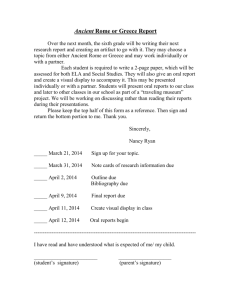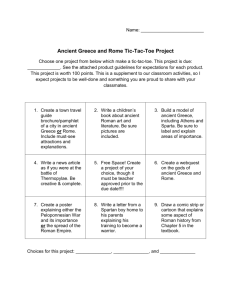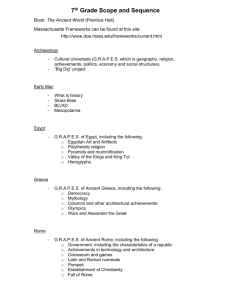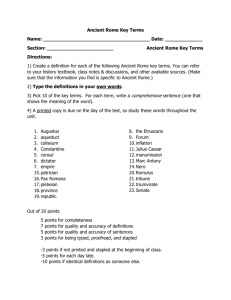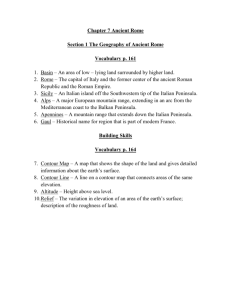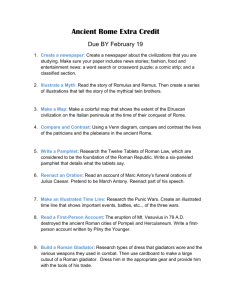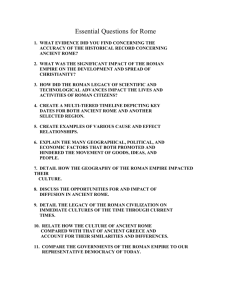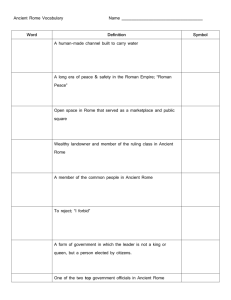Instructional Plans Teacher:_Downing, Mary__Grade:__6__ Week
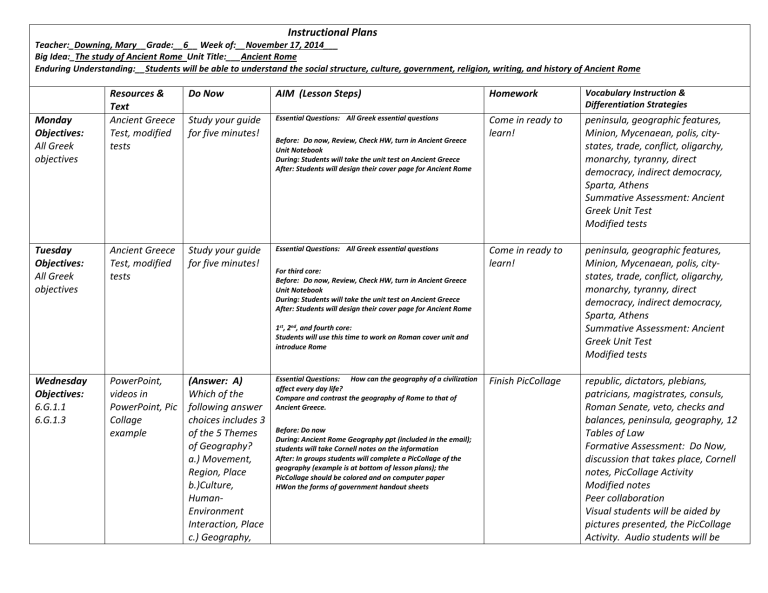
Instructional Plans
Teacher:_Downing, Mary__Grade:__6__ Week of:__November 17, 2014___
Big Idea:_The study of Ancient Rome Unit Title:___Ancient Rome
Enduring Understanding:__Students will be able to understand the social structure, culture, government, religion, writing, and history of Ancient Rome
Monday
Objectives:
All Greek objectives
Resources &
Text
Ancient Greece
Test, modified tests
Do Now
Study your guide for five minutes!
AIM (Lesson Steps)
Essential Questions: All Greek essential questions
Before: Do now, Review, Check HW, turn in Ancient Greece
Unit Notebook
During: Students will take the unit test on Ancient Greece
After: Students will design their cover page for Ancient Rome
Homework
Come in ready to learn!
Vocabulary Instruction &
Differentiation Strategies peninsula, geographic features,
Minion, Mycenaean, polis, citystates, trade, conflict, oligarchy, monarchy, tyranny, direct democracy, indirect democracy,
Sparta, Athens
Summative Assessment: Ancient
Greek Unit Test
Tuesday
Objectives:
All Greek objectives
Wednesday
Objectives:
6.G.1.1
6.G.1.3
Ancient Greece
Test, modified tests
PowerPoint, videos in
PowerPoint, Pic
Collage example
Study your guide for five minutes!
(Answer: A)
Which of the following answer choices includes 3 of the 5 Themes of Geography? a.) Movement,
Region, Place b.)Culture,
Human-
Environment
Interaction, Place c.) Geography,
Essential Questions: All Greek essential questions
For third core:
Before: Do now, Review, Check HW, turn in Ancient Greece
Unit Notebook
During: Students will take the unit test on Ancient Greece
After: Students will design their cover page for Ancient Rome
1 st , 2 nd , and fourth core:
Students will use this time to work on Roman cover unit and introduce Rome
Essential Questions: How can the geography of a civilization affect every day life?
Compare and contrast the geography of Rome to that of
Ancient Greece.
Before: Do now
During: Ancient Rome Geography ppt (included in the email); students will take Cornell notes on the information
After: In groups students will complete a PicCollage of the geography (example is at bottom of lesson plans); the
PicCollage should be colored and on computer paper
HWon the forms of government handout sheets
Come in ready to learn!
Finish PicCollage
Modified tests peninsula, geographic features,
Minion, Mycenaean, polis, citystates, trade, conflict, oligarchy, monarchy, tyranny, direct democracy, indirect democracy,
Sparta, Athens
Summative Assessment: Ancient
Greek Unit Test
Modified tests republic, dictators, plebians, patricians, magistrates, consuls,
Roman Senate, veto, checks and balances, peninsula, geography, 12
Tables of Law
Formative Assessment: Do Now, discussion that takes place, Cornell notes, PicCollage Activity
Modified notes
Peer collaboration
Visual students will be aided by pictures presented, the PicCollage
Activity. Audio students will be
Thursday
Objectives:
6.H.2.4
6.C&G.1.1
6.C&G.1.2
Friday
Objectives:
6.H.2.4
6.C&G.1.1
6.C&G.1.2
PowerPoint, videos, guided notes, Empire of Rome
Reading
PowerPoint,
Twelve Tables
Region, Humans d.) Location,
Climate,
Movement
(Answer: D)
Compared to today’s standards, why is
Athens considered a
“limited” democracy? a/ The Athenian government was not powerful enough to pass laws b/ Citizens of
Athens were unable to participate in debates about government actions c/ Women had to be over the age of 30 to vote and participate in the government d/ Only male citizens were allowed to participate in
Athenian government
What types of things did
Egyptians trade?
Answer: wheat,
Essential Questions: Compare and contrast the structure of
Roman law to that of other civilizations we have discussed.
How can the decisions of a government impact society?
How does a society decide which structure of government works best for them?
Before: Do Now, Check HW, review
During: Roman Republic Notes
Students will complete the guided notes sheet (both the ppt and guided notes are attached in the email)
After: Empire of Rome Reading
Essential Questions: How did the 12 Tables of Law reflect
Rome’s values, thus illustrating the greatness of Rome?
Before: Do Now, Go over Do Now/Check HW, Review
During: Use the Roman Individual and Roman Law ppt; students will take Cornell notes on social classes and law of
Empire of Rome
Reading
Review Notes, Cnote Summary aided by hearing the information and kinesthetic students will be aided by the creation of the
PicCollage. republic, dictators, plebians, patricians, magistrates, consuls,
Roman Senate, veto, checks and balances, peninsula, geography, 12
Tables of Law
Formative Assessment: Do Now, discussion that takes place
Guided notes
Modified notes
Group discussion republic, dictators, plebians, patricians, magistrates, consuls,
Roman Senate, veto, checks and balances, peninsula, geography, 12
Tables of Law
barley, papyrus Rome
After: In pairs students will analyze the 12 Tables of Law, in their IAN students will write down the values expressed by each law and also how the law illustrates advancement in society
Formative Assessment: Review questions for Do Now
Formative Assessment: Do Now, discussion that takes place, Cornell notes, 12 Tables of Law
Cornell notes
Visual representations included in power point
Peer tutoring and collaborative learning
AVID Strategies
Writing: C-notes, guided C-notes, graphic organizers, projects
Inquiry: Graphic organizers, discussions
Collaboration: group/partner work, student led instruction, projects
Organization: Binders, agendas
Reading: Critical reading strategies, graphic organizers
Formative/Summative Assessments: Quizzes, student led instruction, teacher led instruction, Do Now, graphic organizers
52
